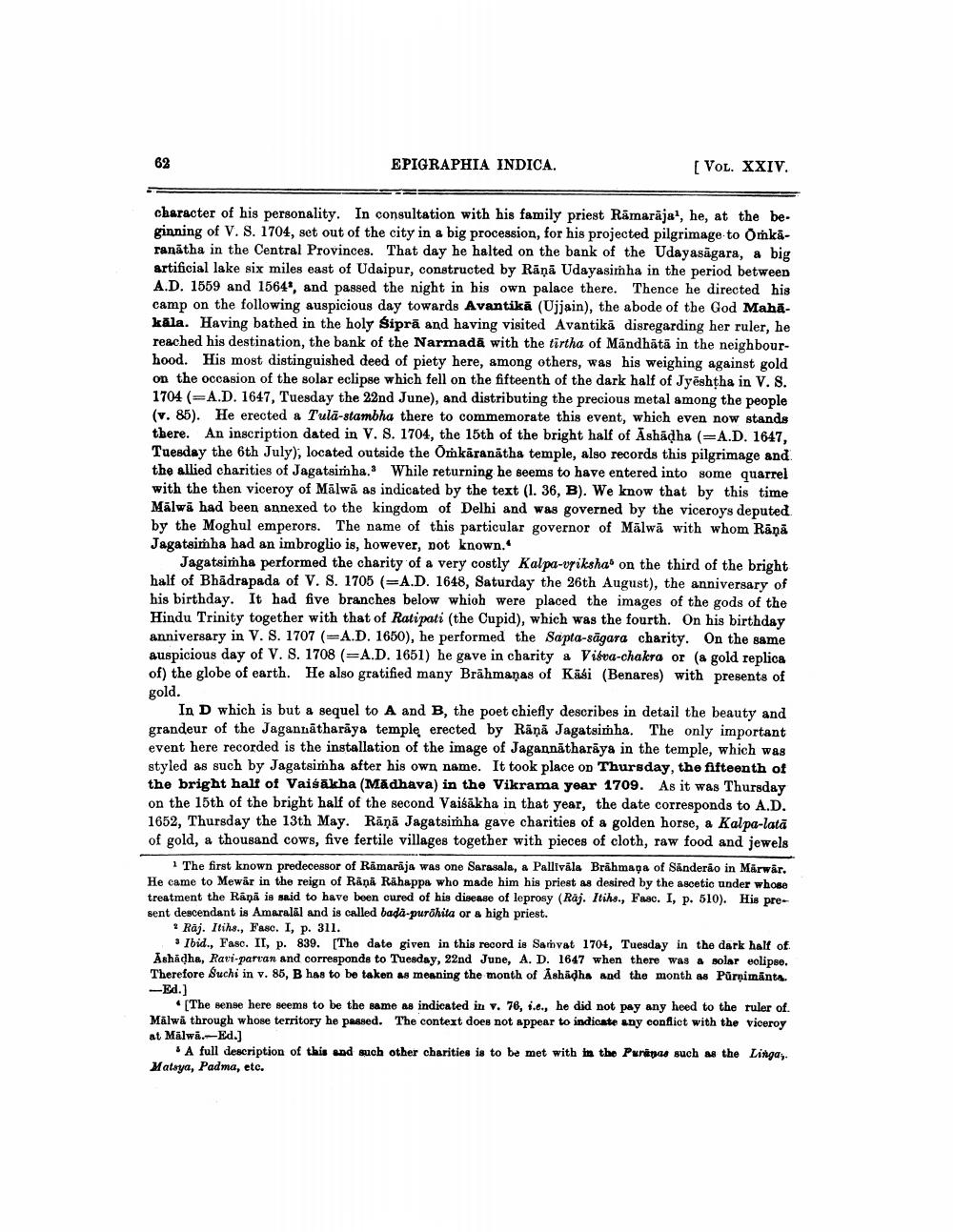________________
EPIGRAPHIA INDICA.
(Vol. XXIV.
character of his personality. In consultation with his family priest Ramarājat, he, at the be. ginning of V. S. 1704, set out of the city in a big procession, for his projected pilgrimage to Omkaranātha in the Central Provinces. That day he halted on the bank of the Udayasāgara, a big artificial lake six miles east of Udaipur, constructed by Rāņā Udayasimha in the period between A.D. 1559 and 1564", and passed the night in his own palace there. Thence he directed his camp on the following auspicious day towards Avantikā (Ujjain), the abode of the God Mahākāla. Having bathed in the holy Siprā and having visited Avantikā disregarding her ruler, he reached his destination, the bank of the Narmadā with the tirtha of Māndhātā in the neighbourhood. His most distinguished deed of piety here, among others, was his weighing against gold on the occasion of the solar eclipse which fell on the fifteenth of the dark half of Jy shtha in V. S. 1704 (=A.D. 1647, Tuesday the 22nd June), and distributing the precious metal among the people (v. 85). He erected a Tulā-stambha there to commemorate this event, which even now stands there. An inscription dated in V. S. 1704, the 15th of the bright half of Ashādha (=A.D. 1647, Tuesday the 6th July), located outside the Omkaranātha temple, also records this pilgrimage and the allied charities of Jagatsimha.. While returning he seems to have entered into some quarrel with the then viceroy of Mālwā as indicated by the text (1. 36, B). We know that by this time Malwa had been annexed to the kingdom of Delhi and was governed by the viceroys deputed by the Moghul emperors. The name of this particular governor of Mālwă with whom Rāņā Jagatsimha had an imbroglio is, however, pot known.
Jagatsimha performed the charity of a very costly Kalpa-vrikshas on the third of the bright half of Bhadrapada of V. S. 1705 (A.D. 1648, Saturday the 26th August), the anniversary of his birthday. It had five branches below which were placed the images of the gods of the Hindu Trinity together with that of Ratipati (the Cupid), which was the fourth. On his birthday anniversary in V. S. 1707 (=A.D. 1650), he performed the Sapta-sāgara charity. On the same auspicious day of V. S. 1708 (=A.D. 1651) he gave in charity a Visva-chakra or (a gold replica of) the globe of earth. He also gratified many Brāhmaṇas of Kasi (Benares) with presents of
gold.
In D which is but a sequel to A and B, the poet chiefly describes in detail the beauty and grandeur of the Jagannātharaya temple erected by Rāņā Jagatsimha. The only important event here recorded is the installation of the image of Jagannatharāya in the temple, which was styled as such by Jagatsimha after his own name. It took place on Thursday, the fifteenth of the bright half of Vaisakha (Madhava) in the Vikrama year 1709. As it was Thursday on the 15th of the bright half of the second Vaišākha in that year, the date corresponds to A.D. 1652, Thursday the 13th May. Rāņā Jagatsimha gave charities of a golden horse, a Kalpa-lata of gold, a thousand cows, five fertile villages together with pieces of cloth, raw food and jewels
1 The first known predecessor of Ramaraja was one Sarasala, a Palliväla Brāhmaşa of Sänderão in Marwar. He came to Mewar in the reign of Rāņā Rāhappa who made him his priest as desired by the ascetic under whose treatment the Rani is said to have been cured of his disease of leprosy (Raj. Itihs., Fasc. I, p. 510). His present descendant is Amaralál and is called bada-purðhita or a high priest.
! Raj. Itihs., Fasc. I, p. 311.
• Ibid., Faso. II, p. 839. [The date given in this record is Samvat 1704, Tuesday in the dark half of Ashidha, Ravi-parran and corresponds to Tuesday, 22nd June, A.D. 1647 when there was a solar eclipse. Therefore Suchi in v. 85, B has to be taken as meaning the month of Ashidha and the month as Púrpimants -Ed.]
[The sense here seems to be the same as indicated in v. 76, i.e., he did not pay any heed to the ruler of. Malwa through whose territory he passed. The context does not appear to indicate any conflict with the viceroy at Mālwā.--Ed.)
A full description of this and such other charities is to be met with in the Puranas such as the Linga, Matsya, Padma, etc.




